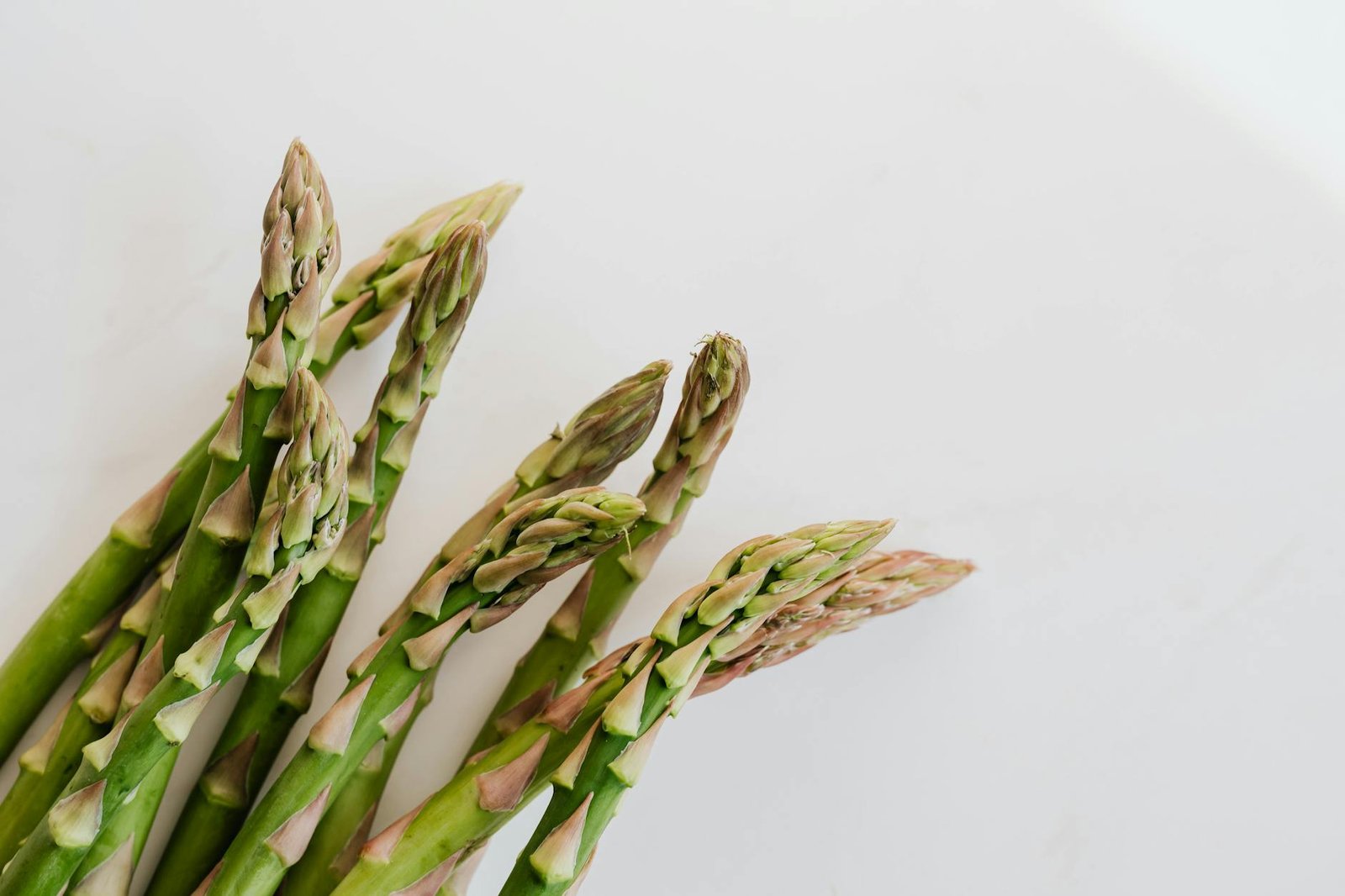Asparagus: A Nutrient-Packed Veggie
Asparagus is a perennial favorite among vegetables for its distinct flavor, versatility in the kitchen, and impressive nutritional profile. When I explore the ins and outs of asparagus, I’m not just looking at how to cook it, but also considering its impact on our health.
The Health Benefits of Asparagus
Asparagus is a powerhouse of nutrients, low in calories but high in vitamins and minerals. It’s a great source of fiber, folate, vitamins A, C, E, and K, as well as chromium, a trace mineral that enhances insulin’s ability to transport glucose from the bloodstream into cells. Here’s a quick overview of its nutritional value per 100g serving:
| Nutrient | Amount |
|---|---|
| Calories | 20 |
| Fiber | 2.1g |
| Folate | 52μg |
| Vitamin K | 41.6μg |
| Iron | 2.14mg |
These nutrients contribute to a myriad of health benefits, such as supporting digestive health, contributing to a healthy pregnancy, and playing a role in bone health. Furthermore, the antioxidants in asparagus, such as glutathione, may help protect against certain forms of cancer and combat the effects of aging.
Importance of Cooking Asparagus Properly
The way we cook asparagus can significantly affect its nutrient content and overall health benefits. Overcooking can lead to a loss of vitamins and can diminish its crunch and flavor, while undercooking might make it hard to digest. To retain the most nutrients and enjoy its natural flavor, I opt for methods that are quick and expose the asparagus to heat for a minimal amount of time. For those who are curious about different cooking techniques, I’ve compiled insights on how can you cook asparagus?, which can guide you to preserve the vegetable’s nutritional integrity while also tickling your taste buds.
Cooking asparagus properly is not just about taste, but also about maximizing its health benefits. By honing in on the most effective methods, we can ensure that asparagus remains a valuable and delicious component of our diets.
Healthiest Cooking Methods
When it comes to enjoying asparagus, not only do I focus on the flavors but also on how healthy the cooking method is. Here, I’ve explored three cooking techniques that ensure my asparagus dishes are nutritious and delicious.
Steaming Asparagus
Steaming is one of the healthiest ways to cook asparagus because it preserves the vegetable’s nutrients and natural flavors. Here’s how I usually steam asparagus:
- Wash the asparagus and trim the tough ends.
- Fill a pot with a few inches of water and bring it to a simmer.
- Place the asparagus in a steamer basket above the water level.
- Cover the pot and let the asparagus steam for about 3-5 minutes, depending on the thickness.
Steaming asparagus can retain a high percentage of its vitamins and minerals compared to other cooking methods. Here’s a simple table to illustrate the nutrient retention in steamed asparagus:
| Nutrient | Retention Rate |
|---|---|
| Vitamin C | 80-90% |
| Vitamin E | 70-75% |
| Folate | 85-90% |
For more details on steaming asparagus, have a look at our guide on how can you cook asparagus?
Roasting Asparagus
Roasting asparagus brings out its natural sweetness and can add a delightful crispness to the tips. Here’s my method for roasting asparagus:
- Preheat the oven to 425°F (220°C).
- Toss the asparagus with a touch of olive oil and seasonings of choice.
- Spread the asparagus in a single layer on a baking sheet.
- Roast for 12-15 minutes until tender and lightly browned.
Roasting asparagus can slightly diminish some vitamins due to the high heat, but it still maintains a good amount of fiber and antioxidants.
Check out the different roasting techniques and their impact on asparagus nutrition in our article on how can you cook asparagus?
Grilling Asparagus
Grilling asparagus can impart a smoky flavor and make for a delightful side dish. Here’s how I like to grill asparagus:
- Preheat the grill to medium-high heat.
- Toss the asparagus with a light coat of olive oil and season it with salt and pepper.
- Place the asparagus perpendicular to the grill grates to prevent them from falling through.
- Grill for 2-3 minutes on each side, until charred and tender.
Grilling is similar to roasting in terms of nutrient retention, especially when the grilling time is short.
For a complete guide to grilling asparagus and maintaining its health benefits, visit our in-depth look at how can you cook asparagus?
By choosing one of these methods, I ensure that the asparagus I serve is not only enjoyable but also retains most of its health benefits. Each technique offers a unique flavor profile and texture, allowing me to mix up my meals while keeping nutrition a top priority.
Flavorful and Healthy Asparagus Recipes
As we delve into the world of asparagus and explore the variety of ways how can you cook asparagus?, it’s exciting to share some of my favorite recipes that not only bring out the best in this nutrient-rich vegetable but are also a delight to the taste buds. These recipes are simple, health-conscious, and perfect for young home chefs looking to add a touch of gourmet to their everyday meals.
Asparagus Lemon Pasta
The zesty flavor of lemon paired with the crispness of asparagus makes for a refreshing and light pasta dish that’s perfect for spring and summer dining. To make Asparagus Lemon Pasta, you will need:
- Whole wheat spaghetti or your pasta of choice
- Fresh asparagus spears, trimmed and cut into bite-sized pieces
- Freshly squeezed lemon juice and zest
- Olive oil
- Garlic, minced
- Grated Parmesan cheese (optional)
- Salt and pepper to taste
Instructions:
- Cook the pasta according to package instructions until al dente.
- While the pasta is cooking, steam the asparagus for about 3-4 minutes until tender but still crisp.
- In a large pan, heat olive oil over medium heat and sauté garlic until fragrant.
- Add the steamed asparagus to the pan and sauté for an additional minute.
- Drain the pasta and add it to the pan with asparagus, tossing to combine.
- Stir in lemon juice, zest, salt, and pepper.
- Serve hot, garnished with grated Parmesan if desired.
This dish pairs beautifully with a crisp white wine and is a testament to the simplicity of flavors when you ask how can you cook asparagus?.
Asparagus and Mushroom Stir-Fry
A stir-fry is a quick and nutritious way to enjoy asparagus with the earthy flavors of mushrooms. Here’s how to create this savory dish:
- Asparagus spears, trimmed and sliced on the diagonal
- A variety of mushrooms, such as shiitake or cremini, sliced
- Soy sauce or tamari for a gluten-free option
- Toasted sesame oil
- Garlic and ginger, minced
- Optional additions: sliced bell peppers, onions, or tofu for added protein
Instructions:
- Heat toasted sesame oil in a large wok or frying pan over medium-high heat.
- Add garlic and ginger, stirring until aromatic.
- Increase the heat to high and add mushrooms, stir-frying until they begin to brown.
- Add the asparagus and continue to stir-fry until the vegetables are tender-crisp.
- Drizzle with soy sauce and toss to coat evenly.
- Serve immediately, garnished with sesame seeds or chopped green onions.
This recipe is a fantastic way to answer the question how can you cook asparagus? while keeping things healthy and flavorful.
Asparagus and Quinoa Salad
For a light yet satisfying meal, try this Asparagus and Quinoa Salad:
- Cooked quinoa, cooled
- Asparagus spears, steamed and chopped
- Cherry tomatoes, halved
- Red onion, finely chopped
- Lemon vinaigrette dressing
- Fresh herbs such as parsley or basil, chopped
- Feta cheese crumbles (optional)
- Salt and pepper to taste
Instructions:
- In a large bowl, combine cooked quinoa, steamed asparagus, cherry tomatoes, and red onion.
- Drizzle with lemon vinaigrette and toss to combine.
- Season with salt and pepper, then add fresh herbs and feta cheese if using.
- Toss gently until everything is evenly mixed.
- Chill in the refrigerator for about 30 minutes before serving to allow the flavors to meld.
Whether you’re enjoying a backyard picnic or a quiet dinner at home, this salad is a wonderful answer to how can you cook asparagus? in a way that’s both tasty and beneficial for your health.
Each of these recipes showcases the versatility of asparagus and how it can be transformed into dishes that are both delicious and nutritionally balanced. Remember, the key to preserving the health benefits of asparagus lies in the cooking method, so keep it simple and let this vibrant green vegetable shine in your culinary creations.
Tips for Maximizing Asparagus’s Nutritional Value
To get the most out of asparagus’s healthful qualities, it’s important to choose, store, and pair it correctly. Here’s how I ensure that my asparagus dishes are not only delicious but also packed with nutrition.
Choosing Fresh Asparagus
Selecting fresh asparagus is the first step to preserving its rich nutrient profile. I look for spears that are bright green with tightly closed tips. You can gently squeeze the stalk; it should be firm and not limp. The ends should look freshly cut, not dry or woody.
When I’m at the market, I also pay attention to the size of the asparagus. While thickness doesn’t necessarily indicate freshness, it can affect cooking time and texture. Whether you prefer thin, delicate spears or thicker ones, just make sure they’re consistent in size for even cooking. Here’s how to tell if asparagus is fresh:
| Feature | Indicator of Freshness |
|---|---|
| Color | Bright green |
| Tips | Tightly closed |
| Stalks | Firm and not limp |
| Ends | Moist and freshly cut |
For more tips on selecting and preparing asparagus, check out our guide on how can you cook asparagus?
Storing Asparagus Properly
Once I’ve picked out the freshest asparagus, storing it properly is key to maintaining its nutritional value. I like to think of asparagus as a flower; it stays freshest when stored upright in a bit of water. I trim the ends and place the stalks in a jar or container with water at the bottom, then loosely cover them with a plastic bag before refrigerating.
Asparagus can last for several days when stored this way, but I try to cook it as soon as possible to enjoy its peak flavor and nutritional benefits. If you need to store asparagus for longer, consider blanching and freezing it. Here’s a simple storage method:
- Trim the woody ends.
- Stand up the spears in a jar with an inch of water.
- Loosely cover with a plastic bag.
- Refrigerate and use within 3-4 days.
For various methods of cooking asparagus while retaining its nutrients, explore how can you cook asparagus?
Pairing Asparagus with Complementary Ingredients
Pairing asparagus with the right ingredients can enhance both its taste and nutritional uptake. I like to add a squeeze of lemon juice not just for flavor, but also because the vitamin C can help absorb the iron in asparagus. Similarly, drizzling a little olive oil can help absorb its fat-soluble vitamins A, E, and K.
When I’m planning meals, I also think about what other foods can complement the asparagus. Foods rich in fiber or protein, such as quinoa or chicken, make for a balanced dish. Here are some pairing ideas:
- Lemon juice or vinegar for flavor and enhancing iron absorption
- Olive oil or other healthy fats for absorbing fat-soluble vitamins
- Fiber-rich or protein-packed foods for a balanced meal
By following these tips and incorporating asparagus into a variety of meals, you can maximize the vegetable’s nutritional benefits. For recipe ideas that highlight the versatility of asparagus, take a look at how can you cook asparagus?



